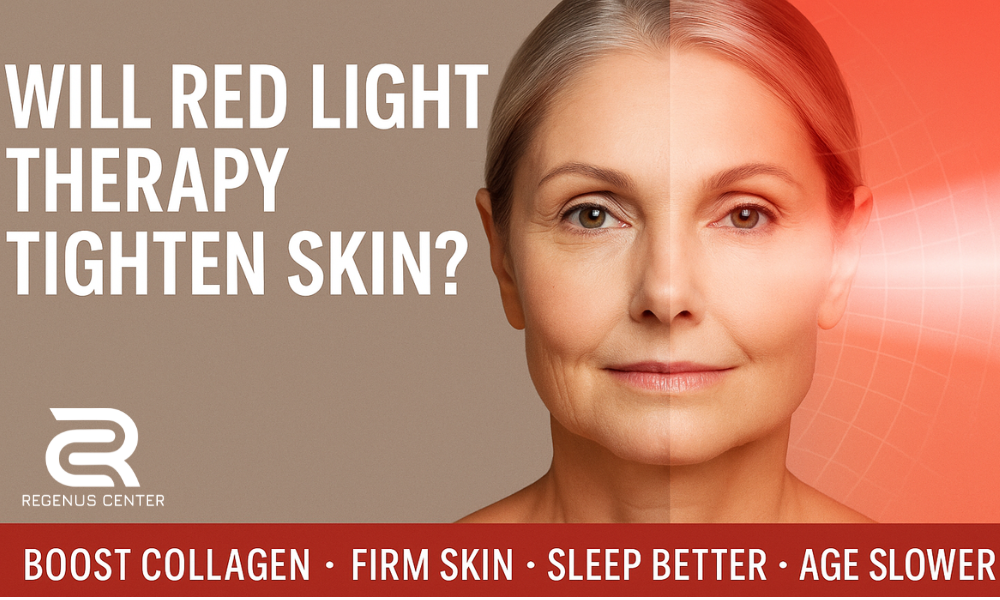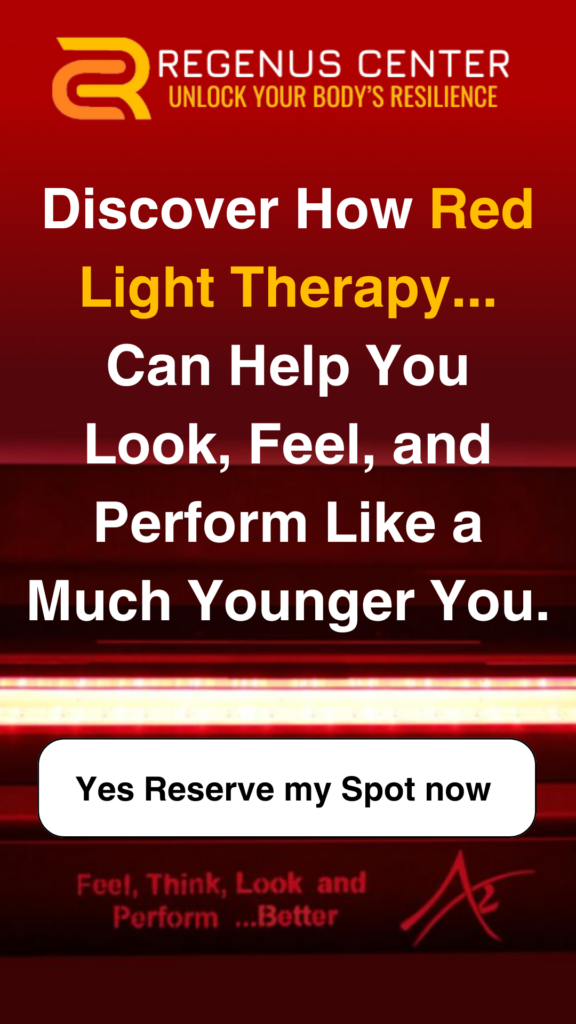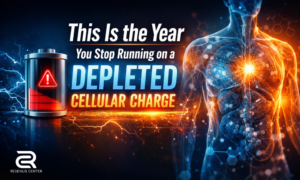Will Red Light Therapy Tighten Skin?
By John Allen Mollenhauer “JAM” CPLC, Founder of the Regenus Center, and The Most Advanced Personal Energy And Performance, Lifestyle Management System for Strivers.
The Quick Take
Will red light therapy tighten skin? Yes, it can. Red and near-infrared light treatment—what we call photobiomodulation (PBM)—has been shown in controlled studies to smooth fine lines and improve firmness. Trials using 633 nm and 830 nm LED light have demonstrated fewer wrinkles, improved elasticity, and stronger collagen in the skin. And unlike lasers or surgery, this isn’t about burning or wounding the skin—it’s about helping your body do what it’s designed to do.
What the Research Shows in Real Life
When I first encountered PBM years ago, what impressed me was the consistency of the results across various studies.
-
In a split-face, randomized, double-blind trial, the treated side showed fewer wrinkles, increased elasticity, and enhanced collagen after several weeks.
-
Another randomized controlled trial confirmed higher collagen density and reported that participants experienced smoother, firmer skin.
-
On a cellular level, PBM has been shown to up-regulate collagen (COL1A1/1A3), elastin (ELN), and hyaluronic acid synthase (HAS2)—the trio responsible for firm, hydrated skin.
In plain English: red light therapy doesn’t “tighten” your face like a facelift. It helps your skin remodel itself from the inside out. That takes time—usually 8 to 12 weeks of consistent sessions—but the changes are real and they last.
Those who achieve the best results incorporate Red Light Therapy PBMt, along with strategic sun exposure, into an entire lifestyle that reinforces these outcomes.
The Grape vs. Raisin Analogy
Here’s how I like to explain it at Regenus Center:
Think of your cells like grapes—plump, hydrated, energized. Over time, and with stress, poor diet, and lack of recovery, they start to look and act more like raisins—deflated, low-energy, dehydrated.
PBMt helps you stay in grape territory in three ways:
-
Energy (cellular charge). Red and near-infrared light stimulate cytochrome-c oxidase in the mitochondria, restoring energy production and improving ATP output. That’s one reason your skin looks firmer and more hydrated after consistent therapy.
-
Scaffolding (collagen & elastin). PBM signals fibroblasts to produce more collagen and elastin, and reduces the enzymes (MMPs) that break them down.
-
Hydration (hyaluronic acid). PBM increases hyaluronic acid synthase, which helps the skin bind and hold water, keeping it plump.
Beyond Skin: Better Sleep, More Energy Awareness
Many of our clients notice something else after starting PBM:
-
They sleep better. In a controlled study with athletes, whole-body red light therapy improved melatonin levels and sleep quality after two weeks.
-
They become more energy aware. You can actually feel when your cells are charging and recovering. That awareness helps people live differently—managing energy rather than just burning through it. And when you manage your energy, you not only look younger—you actually age more slowly.
The Lifestyle Side: Food, Sugar, and “Cell Toxins”
We can’t talk about skin tightening without talking about lifestyle. One of the fastest ways to stiffen and age collagen is through glycation—sugar molecules binding to proteins. Diets high in added sugar and ultra-processed foods accelerate this.
That’s why I often tell our members: avoid poisoning your “grapes.” Limit refined sugar, oil, and salt. Stay hydrated. Choose whole, nutrient-rich foods that protect collagen rather than break it down.
How We Use PBM for Skin at Regenus
When you come into the Regenus Center, here’s how we approach it:
-
Wavelengths: We use red (630–670 nm) and near-infrared (800–880 nm), the most studied for skin rejuvenation. Many trials specifically used wavelengths of 633 nm and 830 nm.
-
Program length: Most clients complete 2–4 sessions per week for 8–12 weeks, then taper to maintenance.
-
Dosing matters: PBM follows a hormetic (sweet spot) dose response—too little isn’t effective, too much can cancel benefits. That’s why we calibrate and guide each session.
-
Safety: PBM is non-invasive, non-thermal, and well-tolerated. We provide eye protection for face treatments and review any medical concerns.
Pairing PBM with Lifestyle for Best Results
For lasting results, PBM works best when paired with:
-
Consistent sleep—your nightly collagen factory.
-
Daily hydration—inside and out.
-
Smart sun habits—to protect new collagen.
-
Low-glycation nutrition—to prevent collagen stiffening.
My Bottom Line for You
So, will red light therapy tighten skin?
Yes, when it’s done correctly and consistently.
If you want firmer, more resilient skin, red light therapy, PBMt is one of the safest and most natural ways to achieve it. It doesn’t override your body—it supports it. By helping your cells hold their charge, reinforcing your collagen framework, and hydrating your tissue, PBM helps keep your skin in grape mode, not raisin mode.
At Regenus, we see these results every day—not just in the mirror, but in the way our members sleep better, feel more energy, and carry themselves younger.
And by the way, when people ask me how I keep my skin so tight and young looking at 57, I always answer: I use red light therapy photobiomodulation regularly, I allow myself to yawn, I get to bed early, and I don’t poison my cells. I also use the sun strategically, and more! I stay vital and live the lifestyle.
References
-
Hamblin MR. Mechanisms of photobiomodulation in human tissue. (Cytochrome-c oxidase, ATP, NO)
-
Zhao J, et al. Effects of red light therapy on sleep quality and melatonin in athletes. J Athl Train.
-
Lee SY, et al. A prospective, randomized, double-blind, split-face trial of LED photorejuvenation. J Photochem Photobiol B. 2007.
-
Wunsch A, Matuschka K. A randomized controlled trial on collagen density after red/NIR PBM. Photomed Laser Surg. 2014.
-
Avci P, et al. Low-level laser (light) therapy in skin: rejuvenation mechanisms. Semin Cutan Med Surg.
-
Smith N, et al. Photobiomodulation: clinical applications in dermatology. J Am Acad Dermatol.
-
JAAD Study. Red/IR up-regulation of collagen, elastin, and hyaluronic acid synthase in skin explants.
-
ASJ Review (2021). Safety and efficacy of PBM for skin rejuvenation.
-
Pageon H. Glycation and skin aging. Clin Dermatol.
-
Whelan HT, et al. Photobiomodulation and systemic energy awareness.
-
Karu T. Mitochondrial responses to PBM: cytochrome-c oxidase pathway.
-
Huang YY, et al. Biphasic dose response in PBM. Dose-Response.





